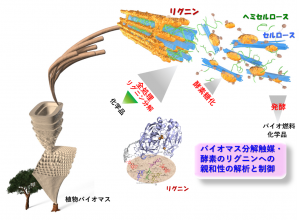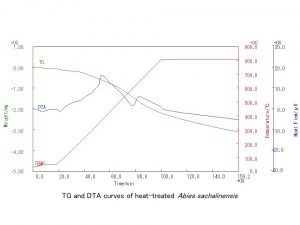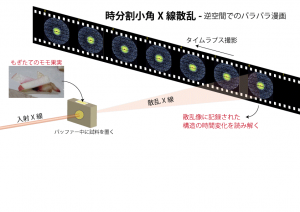2019 Activity Report for Mission 2:
Advanced Development of Science and Technology towards a Solar Energy Society
Updated: 2020/05/15
Research 1: Chemical Valorization of Aldehyde Lignins Produced by CAD-deficient Mutant Plants
Principal Investigator (PI): Yuki Tobimatsu (RISH, Kyoto University)
Research collaborators: Toshiaki Umezawa (RISH, Kyoto University), Xiao Zhang (Washington State University)
Valorization of lignin, a primary component of lignocellulosic biomass, is a major challenge in establishing cost-effective biorefinery systems that realize sustainable societies. In this international collaborative project, we are investigating utilization properties of aldehyde-enriched altered lignins (aldehyde lignins) which are uniquely produced by mutant and transgenic plants deficient in CINNAMYL ALCOHOL DEHYDROGENASE, CAD, a key enzyme gene involved in lignin biosynthesis. Through the analysis of extractability and chemical conversion behaviors of aldehyde lignins produced by a CAD-deficient rice mutant, we demonstrated that introduction of aldehyde lignins positively affect the yields of lignin extraction with some biomass fractionation solvents (e.g., diluted NaOH and deep eutectic solvents) as well as the efficiencies of subsequent chemical and biochemical conversions of extracted lignin and residual polysaccharides into valuable chemicals.
Publications, etc.
- Martin A.F., Tobimatsu Y., Kusumi R., Matsumoto N., Miyamoto T., Lam P.Y., Yamamura M., Koshiba T., Sakamoto M., Umezawa T., Altered lignocellulose chemical structure and molecular assembly in CINNAMYL ALCOHOL DEHYDROGENASE-deficient rice. Sci. Rep., 9, 17153 (2019). doi: 10.1038/s41598-019-53156-8.
Four related conference presentations (3 domestic and 1 international conference presentations).
Research 2: Development of biological and synthetic catalysts for biorefinery
Principal Investigator (PI): Takashi Watanabe (RISH, Kyoto University)
Research collaborators:Hiroshi Nishimura, Yuki Tokunaga, Hiroshi Okano, Kaori Saito, Naoko Kobayashi, Tomohiko Mitani (RISH, Kyoto University), Takashi Nagata, Masato Katahira (IAE, Kyoto University), Katsuhiro Isozaki, Hikaru Takaya, Masaharu Nakamura (ICR, Kyoto University), Kyoichiro Kashimura (Faculty of Eng., Chubu University), Shunichi Irie (School of Env. Sci., Shiga Pref. Univ.)
Control of the affinity to lignin is important to facilitate the activity of lignin- and polysaccharide-degrading (bio)catalysts. Increase in the affinity of ligninolytic (bio)catalysts to lignin is expected to improve the efficiency of the lignin degradation, while suppression of non-productive binding of cellulase to lignin is necessary for enzymatic saccharification with minimum dosage of the enzyme. However, the interaction of polypeptides with lignin has not been clearly understood at the molecular level. We found lignin-binding 12-mer peptide sequences using the phage display technique. These peptides have the potential for use as novel tools that improve the lignin affinity to lignin-degrading catalysts and enzymes. We expressed laccase bearing the lignin-binding peptides and found the mutant enzyme increased activity of lignin degradation. Enzymatic saccharification is an essential process to produce biofuel and chemicals from lignocellulose resources. Cellobiohydrolase I (Cel7A) from Trichoderma reesei has catalytic domain and carbohydrate binding module 1 (TrCBM1) as the C-terminal domain. TrCBM1 possesses high affinity to lignin in addition to cellulose, and the resultant non-productive adsorption inhibits enzymatic saccharification. To understand the molecular interaction, we applied chemical shift perturbation (CSP) and found that TrCBM1 adsorbed cellohexaose in highly specific manner via flat plane surface and cleft while MWLs were adsorbed at multiple binding sites, including the two subsites, having higher affinity than cellohexaose.
Publications, etc.
- Yuki Tokunaga, Takashi Nagata, Takashi Suetomi, Satoshi Oshiro, Keiko Kondo, Masato Katahira and Takashi Watanabe, NMR Analysis on Molecular Interaction of Lignin with Amino Acid Residues of Carbohydrate-Binding Module from Trichoderma reesei Cel7A, Scientific Reports, 9, 1977. (2019).
- Takashi Watanabe, Yuki Tokunaga, Interaction analysis of lignin and its affinity molecules for biomass conversion, Bioscience & Industry, 77, 373-377 (2019).
Overseas invited lecture 1, Domestic invited lecture 1, Other presentations 3.
Research 3: R&D of a Microwave Heating Applicator for Chemical Reaction
Principal Investigator (PI): Tomohiko Mitani (RISH, Kyoto University)
Research collaborators: Daichi Nishio, Naoki Shinohara (RISH, Kyoto University)
A microwave heating applicator utilizing electromagnetic coupling for chemical processing was designed via 3D electromagnetic simulation. We evaluated our developed applicator assuming solvents as heated samples, as well as water. Simulation results indicated more than half of microwave input power was reflected from the applicator. It’s necessary to improve heating efficiency of the applicator for various types of samples.
Publications, etc.
- Mitani, T., Nishio, D., Shinohara, N., “Feasibility Study on Simultaneous Microwave Heating of Multiple Samples by Electromagnetic Coupling-Type Applicator”, 53rd Annual Microwave Power Symposium (IMPI 53), pp.97-99, Las Vegas, USA, Jun. 18-20, 2019.
- Mitani, T., “Recent Trend in Microwave Sources for Microwave Heating Applications”, 2019 URSI-Japan Radio Science Meeting (URSI-JRSM 2019), Tokyo, Japan, Sep. 5-6, 2019.
One presentation in domestic scientific meetings
Research 4: Development of nitrogen-doped carbonized wood
Principal Investigator (PI): Toshimitsu Hata (RISH, Kyoto University)
Research collaborator(s): Sensho Honma (FPRI, Hokkaido Research Organization)
Nanopore structures of carbonized wood play an important role in carbon dioxide storage and electricity storage to solve global warming by unused biomass. Nitrogen doping of carbonized wood was prepared by heat-treated wood adsorbing ammonia or ethylamine at 350 °C and then at higher temperature. The nanopore structure of the woody heat-treated product with enhanced catalytic activity by nitrogen doping was investigated, and the effect of the heat treatment conditions on the interplanar spacing of the porous carbon containing nanopores was studied using an X-ray photoelectron spectrometer and a transmission electron microscope. Analysis revealed that the above-mentioned gas treatment reduced the interlayer spacing.
Publications, etc.
Two presentation in domestic scientific meetings
Research 5: Expansin protein drives the structural change of plant cell wall in its loosening process?
Principal Investigator (PI): Tomoya Imai (RISH, Kyoto University)
Research collaborators: Megumi Ishimaru (Kindai University), Yoshiaki Yuguchi (Osaka Electro-Communication University)
Biomass is solid of polymers in general and produced, of course, by living organisms. Biomass structure is often modified in the lifecycle of the organisms that produced it. This process is, in other words, aqueous structural modification of polymer composite in ambient temperature and pressure. It is then a challenging seed of novel technology of polymer industry as well as scientifically important target.
We launched the study of plant cell wall loosening by expansin protein, a typical example of aqueous polymer-modification. In situ measurement of fruit (peach) maturation was analyzed by small angle X-ray scattering (SAXS) this time, and it was confirmed that SAXS analysis successfully detect the structural change of cell wall structure during the maturation. We will continue to work for reliable interpretation of SAXS data.
Publications, etc.
One presentation in domestic scientific meetings
Mission 2 –related studies (The presented posters at the Mission 2 Symposium)
23 presentations were made at the Mision2 symposium on December 18, 2019 as shown below.
- Estimation of a Direction and Distance of a Target for Microwave Power Transmission
- Development of sugarcane trash fractionation process for an integrative biorefinery platform
- Practical Study on Beamformings for Microwave Power Transfer System to Mini-drones
- The Effect of Microwave on Lytic Polysaccharide Monooxygenases (LPMOs) Reaction
- Reflectionless Microwave Quarter-Wave Plate Using Hyperbolic Metamaterial
- On the relatoship between lignin aromatic composition and lignocellulose utilization properties: a model study using tragenic rice plants
- Study on Microwave Power Transmission System under Multipath Environment
- Role of extracellular metabolites produced by selective white-rot fungi
- Study on Wireless Power Transfer to In-Line Inspection Robots Transmission
- Preparation and analyses of lignin-carbohydrate complex by stepwise enzymatic degradation
- Do a Science Experiment for Future Scientists
- Altered lignocellulose chemical structure and molecular assembly in lignin-modified rice mutants
- Parameter Study of Electromagnetic Coupling-Type Microwave Heating System by Electromagnetic Simulations
- Observation of structural change in the maturation of peach fruit cell wall with small angle X-ray scattering (SAXS)
- Development of a reduced surface wave antenna with dual circular polarization
- Dissolution of Eucalyptus globulus and Japanese Cedar wood meal in organic acids by microwave irradiation
- Development of a 5.8 GHz Magnetron Phased Array
- Development of antitumor lignin-derived substances from plant biomass by microwave solvolysis
- Study on a magnetron for wireless power transfer and communication system.
- Interaction analysis between stable isotope labeled lignin oligomer model and carbohydrate binding module of cellulase
- Design of a 920 MHz Rectifier for Wearable Devices with Microwave Power Transmission
- Biochemical properties of dye-decolorizing peroxidases from a biphenyl/PCB-degrader, Rhodococcus wratislaviensis T301
- Study on Microwave Power Transfer to Rectangular Antenna for Stratospheric Platform






